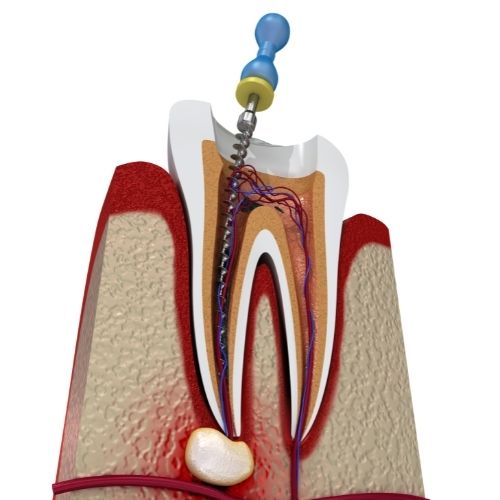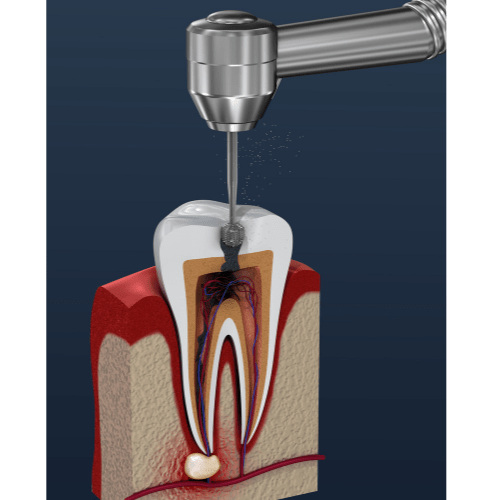Root Canals

Root Canal for Treatment Option
What is a Root Canal?
Root canal procedures are often completed in two steps.
First, the dentist will numb the area to be treated and will remove the inflamed or infected pulp. Your dentist will then clean and shape the inside of the tooth, fill the space and seal the tooth. Your dentist may prescribe antibiotics to help heal the infection and will often create a temporary crown or cap for the tooth. Your dentist will provide you with post-procedure instructions, which include avoiding very hot or cold food or beverages, as well as chewy or hard foods or snacks for a period of time.
In some cases, your root canal may require additional structure due to the creation of the access cavity for the root canal. "Core placement" refers to a procedure where a dentist replaces a missing tooth structure in preparation for making a new dental crown. Replacing these missing portions creates the optimal foundation for the new restoration. Your dentist may recommend the placement of a dental "post" to help anchor the core material to the tooth. Learn more about post and core buildup.
Second, after the infection has cleared and the area is healing, your dentist will clean and seal the tooth again and place a permanent crown over the tooth to protect it from further damage and decay. Once the healing is complete, you should be able to return to the normal use of your teeth. However, it is important to remember that dental restorations need to be of proper care and maintenance to make sure they remain strong and intact.
A pulpotomy is the surgical removal of an inflamed pulp chamber in a child's tooth that has been compromised due to untreated cavities and decay. Bacteria must be removed from the pulp chamber inside the child's tooth in order to prevent or alleviate an abscess or infection. A pulpotomy is commonly referred to as a "baby tooth root canal."
A healthy tooth has a space inside it called the "pulp space," which is filled with soft tissues – nerves, blood vessels, and pink connective tissue. If a tooth gets a large cavity, the bacteria in the decay can damage the pulp, which is often what causes toothache.
Baby teeth are not as hard and strong as adult teeth, and the nerve inside a baby tooth is closer to the outside, which is why children are often both more sensitive and susceptible to decay and tooth pain. Learn more about pediatric pulpotomies.
The cost of a Root Canal in Glenview can vary based on the type of tooth, as well as other variables such as the number of roots and any need for additional services such as Post & Core. Your dentist will review what diagnostics and treatment will be needed, and our staff will review any associated fees prior to beginning root canal therapy.
If you have dental insurance, your coverage may include limited exams and diagnostics, as well as major procedures such as root canals. Our staff is happy to review your coverage with you to ensure you are maximizing your insurance benefits while minimizing any out-of-pocket expenses.
Living with dental pain can be difficult. In some cases, an infection in the tooth is not always immediately painful, but the sooner you seek treatment, the better the potential outcome. It is always best to contact your dentist if you experience any of the following:
- localized pain (can be mild to severe)
- Tooth discoloration
- Swelling or irritation around a tooth
Determination of the need for an emergency root canal can only be made by a dentist or endodontic specialist. Pain, swelling, tenderness in the lymph nodes, or fever may be a sign of a true dental emergency or other serious condition and should never be ignored. If you or a loved one is experiencing any of these symptoms, we recommend you see a dental professional or visit an urgent care center right away.
Where can I get a Root Canal?
A root canal is a modern and very common procedure that can often be performed by a Glance Dental dentist in our Glenview dental clinic. Occasionally, however, a referral to an endodontist, or root canal specialist, for expertise in special cases.
In many cases, your dentist can begin root canal therapy treatment right away. In some circumstances, your dentist may prescribe antibiotics and allow the infection to clear before starting treatment.
There is no specific preparation needed for root canal therapy unless you are receiving Nitrous Oxide (laughing gas) service, in which case it is recommended that you do not eat for 2 hours prior to your appointment.
If root canal therapy is not an option, alternative treatments include extraction of the tooth, with an optional replacement by a bridge or dental implant.
I recently had a root canal and my dentist says I need to come back for a crown. I feel so much better now. Do I really need a permanent crown?
Yes. Many times patients will feel a great amount of relief from swelling or pain following the first part of the root canal treatment has been completed. However, the second step of the root canal is critical to allow your dentist to make sure the infection has cleared and to ensure the tooth is clean and sealed to prevent any openings which may allow food particles, debris, or bacteria to enter the tooth and cause further damage. The placement and [cementing] of the permanent crown is the final step to help protect the tooth and prevent future damage or even tooth loss. Completing the root canal process fully is the best way to prevent future, more costly dental emergencies and keep your smile as healthy and strong as possible.



